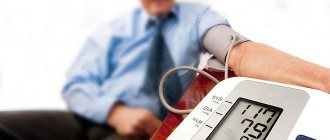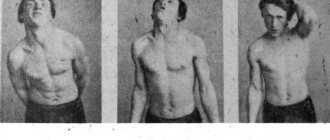There is a large group of disorders of the circulatory system in the human body - neurocirculatory dystonia, this group includes NCD of the hypertensive type.
Cause: disturbance of nervous regulation and vascular tone.
It is diagnosed more often in young people. This is due to dysfunction of the autonomic system.
A group of disorders in which the patient complains of chronic fatigue, lethargy, suffers from insomnia and often feels irritated. Many people do not take these symptoms seriously.
With neurocirculatory dystonia, a person experiences increased systolic and diastolic pressure within normal limits.
Mechanisms of disease development.
V.I. Makolkin developed a classification of VSD. It is based on the mechanisms of the appearance of reactions of the human body to disturbances in the functioning of the autonomic nervous system.
The autonomic nervous system is responsible for regulating the functioning of internal organs. It consists of the parasympathetic, when it is excited, the organs begin to work faster, and the sympathetic, it performs the opposite function and slows down the functioning of the organs. Thanks to them, all organs and systems in the body work harmoniously.
Disturbances in the functioning of this system are neurocirculatory dystonia, when the body works uncoordinated. For example, when a system must work intensively, inhibition occurs and vice versa. This happens because the regulation of one of the sections of the ANS predominates.
neurocirculatory dystonia occurs when the parasympathetic department predominates. The activity of their work depends on the activity of blood flow into organs. This is how control is carried out. To do this, at the right moment, the walls of blood vessels expand or contract, thus regulating the supply of blood to the organs and systems of the ANS.
Thus, a certain amount of blood circulates to the organ at a certain period of time. But when the parasympathetic system reduces vascular tone, it malfunctions. Therefore, systolic pressure decreases, which is the main symptom of NCD.
The organs do not receive enough nutrients, resulting in other symptoms of the disease. Tissue hypoxia and dystrophy may occur.
Such changes in the body are recorded and automated, and neurocirculatory dystonia becomes an independent disease. A pathological reaction occurs after the action of a certain irritant, it could be stress or a change in weather conditions.
Treatment of cardiac type NCD
One of the main tasks when getting rid of pathology is to stabilize the patient’s lifestyle and habits: normalizing sleep, choosing a gentle work regime, selecting adequate and regular physical activity, giving up bad habits, eliminating sources of nervous tension.
The most effective is complex therapy for NCD, carried out in several directions at once:
- Physiotherapy. Includes therapeutic exercises, regular sports, acupuncture sessions, electrosleep, manual and other types of massages, darsonvalization, electrophoresis using drugs prescribed by a doctor.
- Drug therapy. In relation to the nature and severity of the disease, it implies the use of nootropics, tranquilizers, antidepressants, cerebroangiocorrectors and sedatives.
- Phytotherapy. It is used in the form of decoctions of medicinal herbs, which have the same symptomatic effect as medications.
In order to prevent neurocirculatory dystonia, experts recommend giving up bad habits, introducing regular exercise, maintaining sleep and nutritional patterns, avoiding not only physical, but also emotional overload. You can listen to meditations and audio trances for preventive purposes, for example, a specialist in working with fears and panic attacks, Nikita Valerievich Baturin:
Types of NDC
Symptoms of the disease occur differently in all patients.
But the essence and reason are the same: a person’s autonomic nervous system is disrupted and neurocircular dystonia is formed.
There are several types of NDC, depending on the blood pressure indicator:
- neurocirculatory dystonia of the hypertensive type - pressure constantly increases, changes do not depend on age-related changes;
- neurocirculatory dystonia of the hypotonic type - there is constant lethargy and a feeling of weakness, with low blood pressure and pulse;
- neurocirculatory dystonia of a mixed type - symptoms of the two previous types appear. This happens unexpectedly for the patient, and it is not clear when any symptoms will appear.
NCD for the hypertensive type: what are the features of the disease, treatment and prevention
Additional education:
"Emergency Cardiology"
1990 – Ryazan Medical Institute named after Academician I.P. Pavlova
Contacts
Neurocirculatory dystonia is considered to be cardiovascular disorders of a complex functional nature, and the most common manifestation of the disease is considered to be hypertensive type NCD. The disease manifests itself with various cardiovascular symptoms, which can arise and worsen under the influence of stressful conditions.
Cardiopsychoneurosis
Dystonia is divided into two types: vegetative-vascular, neurocirculatory. In the first type, dysfunction manifests itself in a number of organ systems. The neurocirculatory type mainly produces a cardiovascular pattern of symptoms. Neurocirculatory dystonia is also called neurocirculatory asthenia (NCA). NCD of the hypertensive type is the leader among other types of this pathology.
Cardiologists, neurologists and therapists most often encounter this diagnosis. Patients of cardiologists and general practitioners account for approximately 30% of patients with NCD of the total number.
Dysfunction can develop in people of different ages and genders, but young people are most often susceptible to it. Moreover, according to statistics, female representatives suffer from this disease almost 2 times more often than male representatives.
It is extremely rare that the disease can develop in people over 40 and under 15 years of age.
Classification
Neurocirculatory dystonia is divided into several forms:
- Infectious-toxic;
- Neurotic;
- NDC physical overexertion;
- Mixed;
- Essential;
- Dishormonal.
According to the clinical picture, the disease can also be divided into four types (as a diagnosis) depending on the characteristic symptoms:
- Hypertensive NCD with increased pressure;
- Hypotensive NCD with a decrease in pressure;
- Cardiac NCD with cardiac dysfunction;
- Mixed, in which disorders of the heart and blood pressure are combined.
Based on the severity of the disease, mild, moderate, and severe degrees of NCD are distinguished. With a mild degree, the symptoms do not manifest themselves clearly enough and the patient does not lose his ability to work, feeling satisfactory. The attack is provoked by stress.
With moderate severity, performance is halved. At this stage, it is necessary to begin treatment with medications. In severe conditions, a person completely loses his ability to work, and the symptoms are persistent. In such cases, therapy is carried out in a hospital setting.
As the disease progresses, it may be in remission or exacerbation.
Reasons for development
Various factors can trigger the development of the disease. In adolescents, neurocirculatory dystonia occurs as a result of insufficient formation of the neuroendocrine mechanism, which is not yet capable of fully regulating the processes required for the body. In general, for people of different ages, a number of factors have been identified that can cause the development of the disease:
- Stress, mental trauma, emotional turmoil;
- Unfavorable social and economic conditions;
- Excess sun exposure;
- Vibration effect on the body (regular);
- High air temperature;
- Regular intoxication of the body (chemicals, alcohol, drugs, smoking, and so on);
- Infections of the ENT organs and upper respiratory tract;
- Lack of movement and physical activity;
- Hereditary factor;
- Overwork.
The process of disease development is also influenced by time periods related to hormonal imbalances in the body: pregnancy, menopause, abortion, ovarian dysfunction, puberty. The impact of several causes at once often leads to disruption of the internal mechanisms of the body. As a result, neurocirculatory dystonia of the hypertensive type occurs.
Symptoms
Symptoms vary depending on what type of disease the patient has. If we talk about the general manifestation of NCD, then the person is in a neurosis-like state. He experiences increased fatigue and constantly complains of weakness. Attention, memory, and sleep deteriorate. Against this background, mood swings, irritability, and decreased volitional qualities become especially pronounced.
The patient often complains of shallow breathing and insufficient inspiration. He has a persistent desire to go out into the fresh air. A foreign body is felt in the throat.
In a stuffy room, such a person feels uncomfortable and constantly wants to go outside. Often NCD occurs in the form of attacks of anxiety and fear. Other manifestations are circulatory in nature.
In general, this type of disease is characterized by approximately 40 symptoms. Each patient has from 9 to 26 signs, including:
- Increase in blood pressure to 140/90mm;
- Headache;
- Feeling of pulsation of the vessels of the cervical spine;
- Obesity;
- Heart pain, interruptions in his work, increased heartbeat;
- Dizziness;
- Shortness of breath, respiratory dysfunction, especially with intense walking;
- Cooling of the extremities and regular chills;
- Nausea, abdominal pain;
- Mental symptoms: irritability, fatigue, emotional swings, fear, anxiety, and so on;
- Heat in the neck and face, which is sometimes accompanied by fainting or a similar condition.
The symptoms of the disease are quite varied, but neurotic, autonomic and cardiovascular disorders are most evident. The main manifestation is pain.
Almost all patients complain of pain in the heart area. It occurs only from time to time under the influence of external factors.
The mechanism of its occurrence has not yet been studied, although various hypotheses have been put forward.
Hyperhidrosis (increased sweating) is also characteristic of NCD of the hypertensive type. The palms are cold and wet. Heart rate reaches a threshold of 100 beats per minute. This indicator depends on the breathing phase. It is able to change with changes in body position. This disease should be distinguished from stage 1 hypertension. With hypertension, the patient has fewer complaints.
In more than half of the cases of hypertensive type NCD, the increase in blood pressure is not accompanied by severe symptoms and deterioration of well-being.
Diagnosis of this pathology is made by exclusion. To do this, you need to visit a number of specialists, including a neurologist, endocrinologist, cardiologist and others. They, in turn, can prescribe a number of activities according to their profile - from analysis to hardware examination (X-ray, ECG, ultrasound, and so on).
Drugs for NCA
The following types of drugs are used in the treatment of neurocirculatory dystonia of the hypertensive type:
- Sedatives (Belloid, motherwort tinctures, valerian, Bellaspon, Persen);
- Tranquilizers (Diazepam, Medazepam, Elenium, Phenazepam, over-the-counter analogs - Afobazol and Tenoten);
- Antidepressants;
- Nootropics (Pantocalcin, Nootropil, Picamilon, Piracetam, Phenotropil);
These drugs are designed to relieve the root cause of the pathology - that is, stress. Doctors give preference in the first stages of drug treatment to herbal medicine, that is, to those products in which herbal and simply natural ingredients predominate.
Tranquilizers are prescribed in cases where the patient obsessively experiences feelings of fear, irritation, anxiety and cannot cope with them in other ways.
These are mostly prescription drugs, although Tenoten is an over-the-counter homeopathic remedy. Antidepressants are prescribed only in cases where depression is hidden behind the disease.
These drugs are also classified as prescription drugs.
Nootropics are designed to improve brain activity, help improve attention, memory, and strengthen blood vessels in the brain. Such drugs are of enormous benefit in the treatment of dystonia.
Psychotherapy and other methods
Psychotherapy is considered the best treatment option. They help a person cope with stress in natural ways without the use of medications. In the process, methods such as auto-training, relaxation and others can be used. If psychotherapy does not produce a tangible result, then the specialist can also include drug treatment, as well as physical therapy.
Classification
Now there are two classifications of NCD, etiological and according to the severity of symptoms.
The etiological classification was developed by S. A. Abbakumova and V. I. Makolkin, they identified the following main factors:
- Essential – manifests itself due to hereditary predisposition.
- Psychogenic, occurs against a background of constant stress.
- Infectious-toxic.
- Due to constant physical stress.
- Features of a person's profession.
There are also three forms of the disease according to severity: mild, moderate and severe.
Causes
Neurocirculatory dystonia is divided into two categories: primary and secondary. The causes of primary neurocirculatory dystonia are:
- asthenic syndrome against the background of natural growth of the body and hormonal changes in adolescents; stressful conditions, mental shocks;
- sudden climate change (hypothermia and overheating, prolonged unusual insolation, increased and decreased atmospheric pressure);
- violation of the correct lifestyle (smoking, unhealthy high-calorie foods or fasting, physical inactivity or excessive debilitating physical activity, drug use);
- sleep-wake disorder;
- hereditary predisposing factors (often in people with connective tissue dysplasia);
- uncontrolled consumption of alcohol-containing drinks, including low-alcohol drinks, as well as tonic drinks.
Secondary neurocirculatory dystonia occurs against the background of severe asthenic syndrome due to infectious invasion, against the background of helminthiasis, oncological pathology, hormonal imbalances in diseases of the endocrine glands, etc.
The pathogenesis and mechanisms of development of dystonia have not been fully studied. The main theory is a disruption of blood homeostasis when the neurohumoral background changes, as interruptions occur in the functioning of the hypothalamic-pituitary system. Because of this, the interaction between the parasympathetic and sympathetic systems is disrupted; the vessels and myocardium are the first to react to changes. Gradually, a stable response of the cardiovascular system is formed, and the disease becomes type-specific.
Asthenia of the neurocirculatory type occurs in people due to a provoking factor. Medical experts believe that the basis of the disease is nervous exhaustion, as well as metabolic disorders. At the same time, various diseases that can be diagnosed in a person, as well as external factors, can lead to such conditions.
Main reasons:
- Overwork. If a person is often very tired, then he may face various health problems. It is for this reason that you should get as much rest as possible, so that you don’t have to face serious health problems later.
- Chronic fatigue. In this case, a person constantly feels weak and tired, but he does not feel like he is resting. Even in the morning you may not have the energy to do various things and even take on hobbies.
- Alcohol abuse. Alcoholic drinks generally have a negative effect on the body. That is why they should not be consumed regularly, but it would be better to completely give up alcohol. If this is not done, then a person may experience neurocirculatory asthenia.
- Infectious diseases. Mostly the disorder is caused by pathologies that affect the upper respiratory tract and are chronic.
- Intoxication. Regular poisoning, especially with chemicals, has an extremely negative effect on the condition of the body. They also lead to asthenia, which in turn worsens a person’s well-being.
- Often the disease can occur during pregnancy, miscarriage, or abortion. This can be explained by the fact that strong emotional stress can serve as a trigger.
It is also worth noting that the appearance of neurocirculatory asthenia is more likely to occur during hormonal surges, as well as in the presence of poor heredity.
If a person has an unstable psyche, then he may also encounter a disease. As you can understand, there are many factors leading to the development of pathology, so it cannot always be avoided.
It is within the power of any person to pay attention to the first symptoms in order to begin treatment immediately. In this situation, you will be able to significantly improve your well-being.
Causes of violations
Neurocirculatory dystonia of the hypertensive type occurs due to the action of many factors.
One thing can be said for sure: NCD does not occur as a result of organic disorders of the endocrine or nervous system.
The causes of the pathology are:
- constant overwork;
- lack of sleep;
- decreased human activity;
- regular physical activity and resulting overexertion;
- negative emotional background;
- severe diseases of internal organs;
- traumatic brain injuries of varying severity;
- acclimatization;
- hormonal imbalances in the body;
- acute infectious diseases.
The development of the disease is also influenced by hereditary factors and individual characteristics of the body. People whose relatives suffer from heart and vascular diseases are at risk.
Causes of neurocirculatory asthenia
Neurocirculatory asthenia is a chronic functional disease.
It affects young and middle-aged people (16-40 years), more often women. Found in 25-30% of people.
Personality characteristics, heredity, and periods of hormonal changes may predispose. Causing factors: psycho-emotional and physical stress, fatigue, consequences of infections (chronic tonsillitis, ARVI) and intoxication.
Pathogenesis. The cause of dysregulation may be dysfunction of hypothalamic structures with disruption of their coordinating and integrative role. There may be a violation of the oxygen supply to tissues with the accumulation of lactic acid. There is a disruption of metabolic processes with the development of dystrophy.
In the hypotonic variant of NCA, the impact of neuropsychic stress, infection, etc. lead to increased activity of the n.vagus and a decrease in the functional activity of the sympathoadrenal system. There is a decrease in arteriolar tone. Systolic and minute volumes increase compensatoryly.
Variants are distinguished according to the predominance of clinical manifestations (types): cardiac, hypertensive, hypotensive and mixed. Complications (rhythm disturbances, etc.) are noted.
An example of a diagnosis: Neurocirculatory asthenia of the hypertensive type. Rare supraventricular extrasystole. BUT.
In the cardiac variant, there is aching, stabbing, burning or bursting pain in the area of the apex of the heart, less often - parasternally and behind the sternum, which can migrate, but irradiation is not typical. More often the pain is weak or moderate, instantaneous “piercing”, but it can also be long-term monotonous. Sedatives relieve pain. Typical symptoms include tachycardia, palpitations, and a feeling of pulsation in the blood vessels of the neck.
The hypertensive type of the disease is manifested by an increase in blood pressure, which usually does not exceed the borderline values (140-150/90-95 mm Hg). Blood pressure may be labile. There was no subsequent association with hypertension.
The hypotensive form is diagnosed by a decrease in blood pressure. Asthenic syndrome is manifested by a decrease in physical performance, weakness, and increased fatigue.
Respiratory disorders occur in the form of increased breathing, some patients experience deep “melancholy” sighs or a feeling of a “lump” in the throat. Poor health in stuffy rooms, transport, need to open windows. Some patients have thermoregulation disorders: an increase in temperature to 37.2-37.5°C, temperature asymmetry, and its lability during the day.
The diagnosis is established by exclusion: hypertension, myocarditis, hyperfunction of the thyroid gland, neurasthenic syndrome, etc.
In the diagnosis of NCA, identifying the diversity and lability of symptoms (pulse, blood pressure), identifying autonomic dysfunction, benign course and dissociation between numerous complaints and the paucity of objective data are of great importance.
Bicycle ergometry allows you to identify a hypertensive or hypotensive type of reaction, a decrease in physical performance up to 70-110 W. Daily blood pressure monitoring objectifies the data. A consultation with a neurologist is needed to identify autonomic dysfunction.
EchoCG may occasionally reveal additional chords and trabeculae in the cavity of the left ventricle, the tension of which may be a morphological substrate for the appearance of pain in the cardiac region.
Differential diagnosis. Carry out the hypertensive syndrome with hypertension and symptomatic hypertension. Unlike hypertension, there is a systolic increase in blood pressure, and not a systolic-diastolic increase; it is usually no more than 150/95 mm Hg. Art., while the pulse and hypertension are labile, there is no damage to target organs.
The cardiac form of NCA is differentiated by the syndrome of cardialgia with ischemic heart disease and non-coronary heart diseases (myocarditis, cardiomyopathies, pericarditis), diseases of other organs with chest pain syndrome: diseases of the respiratory system (pneumonia, pleurisy, lung cancer), digestive organs (esophagitis, hiatal hernia openings of the diaphragm), diseases of the nervous system and muscles (myositis, osteochondrosis of the thoracic spine), herpes zoster, etc.
Unlike acute rheumatic fever, there is no connection with streptococcal infection, there is no pain in the joints, there is no increase in acute phase parameters, or subsequent development of heart disease, mainly with damage to the mitral valve.
NCA of the hypotensive type is differentiated from asthenoneurotic syndrome, physiological hypotension (individual variant of the norm, increased training, adaptive - in high mountains), symptomatic (secondary) hypotension: acute (with shock, collapse); adrenal insufficiency, hypothyroidism, etc.
Etiotropic measures are carried out. Sharp limitation of alcohol consumption and smoking. Measures to normalize the daily routine and night sleep, avoiding stress.
For cardiac and hypertensive variants, a diet with limited salt and liquid is recommended. Sedatives: extracts of valerian, motherwort, hawthorn, Corvalol.
To reduce high blood pressure, relieve cardialgia and arrhythmias, the use of β-blockers (anaprilin; atenolol, metoprolol) or verapamil is effective.
For neurosis and anxiety symptoms, it is possible to prescribe anxiolytics (tranquilizers) in minimally effective doses and for a short period of time: Seduxen (5-30 mg/day, for insomnia 5-15 mg at night), Elenium, Sonapax. For depressive disorders - antidepressants.
Exercise therapy - dynamic exercises. Physiotherapeutic procedures: galvanic collar according to Shcherbak, electrophoresis of bromine (for insomnia), magnesium (for hypertension) using the method of general influence or on the collar zone, therapeutic baths (coniferous, carbon dioxide) at a temperature of 35-36 ° C, electrosleep, electroanalgesia, acupuncture.
An effective treatment method is psychotherapy.
For the hypotensive option, use a diet rich in proteins and extractives, coffee, and tea. Neurostimulants (adaptogens) of plant origin are recommended: ginseng, eleutherococcus, zamanikha. Vitamin therapy. The effect may be observed from sedatives and anxiolytics. Exercise therapy - static exercises.
Physiotherapeutic procedures: circular shower, Charcot shower - at 35-20 ° C, underwater shower-massage, douches and rubdowns; pine, oxygen and pearl baths at a temperature of 32-33 ° C, electrophoresis of caffeine (according to Vermeule), calcium, etc., galvanic anode collar (with severe asthenia), diadynamic therapy of the cervical sympathetic nodes, massage, self-massage of the limbs and torso.
Symptoms
NCD of the hypertensive type manifests itself in patients differently, the following symptoms are more common:
- weakness;
- a person feels tired even after minor exertion;
- frequent presyncope;
- changes in heart rate;
- headache;
- breathe heavily;
- sleep problems;
- frequent pain in the heart area;
- meteosensitivity and weather dependence.
There is also an increase in heart rate to 100 beats per minute. The person sweats a lot and has cold palms. The whole body or individual areas can sweat.
Also with this disease, dermographism occurs, when the skin changes color after mechanical impact. Therefore, if you run something over the patient’s skin, there will be white marks that go away very slowly.
The same symptoms appear in patients with NCD of the hypotonic type, only their blood pressure and pulse are lowered.
Symptoms occur periodically, all signs do not appear at the same time, their constant alternation is observed.
Symptoms of neurocirculatory dystonia
A common manifestation for all types of neurocirculatory dystonia is a neurosis-like state, characterized by fatigue, weakness, sleep disturbance, irritability, decreased memory, mood and volitional qualities, deterioration in concentration, which is accompanied by functional circulatory disorders of a predominant nature.
The course of the cardiac type of neurocirculatory dystonia is manifested by cardialgia, palpitations, interruptions in heart function, and sometimes shortness of breath during physical activity; no significant changes in blood pressure are observed. Objectively, tachycardia, respiratory arrhythmia, paroxysms of tachycardia, supraventricular extrasystoles, changes in cardiac output inadequate to the load can be determined, and on the ECG - a change in the voltage of the T wave (high or reduced).
Neurocirculatory dystonia of the hypotensive type is characterized by symptoms of chronic vascular insufficiency: a decrease in systolic blood pressure less than 100 mm Hg. Art., chilliness of the feet and hands, a tendency to orthostatic collapse and fainting. Also, for patients with the hypotensive type of NCD, complaints of fatigue, muscle weakness, and headaches are typical. Such patients, as a rule, have an asthenic physique, pale skin, and cold and damp palms.
The hypertensive type of neurocirculatory dystonia is characterized by a transient increase in blood pressure to 130-140/85-90 mmHg. Art., which in half of the cases is not accompanied by a subjective change in the patients’ well-being and is detected during medical examinations. Complaints of palpitations, headaches, and fatigue are less common. The hypertensive type of NCD in its characteristics coincides with borderline arterial hypertension.
The fundamental principle of the clinical course of any form of neurocirculatory dystonia is the dissonance between the patient’s expressed subjective sensations and the scant signs revealed during the initial objective examination of the patient. To facilitate the diagnosis of this disease, the entire wide range of clinical symptoms is divided into several groups of clinical syndromes.
Systemic vascular dystonia with predominant hypertension is manifested by the following symptoms:
Signs of any type of neurocirculatory dystonia are:
- weakness, fatigue;
- sleep disorders (insomnia, frequent awakenings at night, after waking up in the morning a person still feels tired);
- headache of unclear localization, dizziness;
- irritability;
- bad mood, lack of desire to do household chores and work, lack of motivation to gain new knowledge;
- decreased concentration;
- increased sweating, especially in stressful situations;
- sensations of heat in the face and entire head, “hot flashes”;
- feeling of lack of air;
- chilliness of hands and feet;
- vegetative-vascular crises.
Vegetative crises are of 2 types:
Symptoms of mixed type neurocirculatory dystonia may differ in different patients, but, to a large extent, the pathology manifests itself:
OUR READERS RECOMMEND!
For the prevention and treatment of cardiovascular diseases, our readers recommend the drug “ReCardio”. This is a natural remedy that acts on the cause of the disease, completely preventing the risk of heart attack or stroke. ReCardio has no contraindications and begins to act within a few hours after its use. The effectiveness and safety of the drug has been repeatedly proven by clinical studies and many years of therapeutic experience.
- weakness;
- rapid fatigue;
- pre-fainting states;
- changes in heart rate;
- headache;
- difficulty breathing;
- insomnia or shallow sleep;
- weather dependence;
At the same time, it is not at all necessary that all symptoms will be observed simultaneously; on the contrary, some will be replaced by others, and so on. We will talk about how neurocirculatory dystonia is diagnosed in the next section.
Diagnosis of the disease
Since the symptoms are nonspecific, doctors need to conduct diagnostics to determine the disease. At the first appointment, it is difficult to determine the disease; diseases of the cardiovascular system are often suspected. To confirm NCD of the hypertensive type, it is necessary to conduct a number of studies.
If symptoms last more than 2 months, the patient periodically notes the manifestation of symptoms of the disease. And they are associated with unpleasant situations, and times when hormonal levels are unstable, then the disease proceeds in waves, with periods of remission, absence of symptoms, and exacerbations, does not progress rapidly.
To confirm the diagnosis, it is necessary to study the systolic (upper) and diastolic (lower) blood pressure readings. It is measured dynamically and under light physical activity. They do an ultrasound and an ECG. More often, an ECG diagnoses arrhythmia, but an ultrasound does not show changes in the structure and function of the heart and blood vessels.
Doctors use dynamic stress ECG tests to accurately make a diagnosis.
- A physiological test involves hyperventilation, you need to actively breathe for 40 minutes, the patient breathes actively, after which an ECG is performed. The indicators are compared with the original ones. If the pulse rate increases by 50% or more, and negative T waves appear on the ECG or the amplitude increases, this indicates NCD.
- An orthostatic ECG test is recorded after changing the patient’s body position. First in a lying position, then after the patient has stood for 15 minutes. A positive result, the presence of a disease, is indicated by the same changes as during the test with hyperventilation.
- Tests using drugs. To do this, a medicine is administered and ECG readings are taken after 60 minutes. The indicators are compared before and after drug administration.
Differential diagnosis of NCD
The main signs of neurocirculatory dystonia of the hypertensive type are an irregular increase in systolic pressure up to 140 mm Hg, caused by severe physical or psycho-emotional stress. The following methods will help reduce indicators:
- complete rest;
- regulation of sleep and wakefulness;
- relaxation;
- taking sedatives.
The following symptoms are associated with increased systolic pressure in NCD:
- rapid heartbeat;
- visible pulsation of large veins on the wrist, under the knee, etc.;
- lack of air;
- heaviness in the chest;
- weakness, increased fatigue;
- nervousness, increased emotionality;
- insomnia or drowsiness;
- attention disorders, memory impairment;
- sweating;
- trembling in the body and limbs;
- changes in movement coordination.
It happens that against the background of high blood pressure, patients with NC dystonia of the hypertensive type experience symptoms:
- pain in the heart area;
- shortness of breath and difficulty breathing;
- loss of appetite;
- abdominal discomfort;
- feeling of lack of fruits and sweets.
To diagnose NCD of this type, it is necessary:
- study the indicators and surges in systolic and diastolic blood pressure at rest and during physical activity;
- examine the ECG, which determines arrhythmia;
- do an ultrasound of the heart and blood vessels;
- Carry out daily monitoring of ECG and blood pressure.
Characteristic signs and indicators allow one to distinguish between NCD and hypertension. Thus, hypertension is characterized by:
- increased blood pressure;
- damage to the heart, eyes, kidneys, brain;
- taking sedatives does not regulate blood pressure levels;
- blood pressure surges do not depend on the time of day or stressful situations;
- Blood pressure levels stabilize after taking medications.
The differences between hypertension and NC dystonia of the hypertensive type help to correctly diagnose the disease and determine the method of treatment.
Despite the fact that the signs of this disease are varied, a number of patterns can be identified in its manifestation.
From the cardiovascular system:
- cardialgia with aching, stabbing, squeezing or pressing pain radiating to the upper half of the chest;
- sinus tachycardia from 90 to 140 beats. in min.;
- increased systolic blood pressure – up to 140 mm. rt. Art., especially during physical activity or emotional stress;
- heaviness, pain and discomfort in the heart area: interruptions, tremors, feeling of emptiness or fading;
- labored breathing;
- visible pulsation of the popliteal, radial and carotid arteries.
From the nervous system:
- migraine;
- sleep disorders such as drowsiness or insomnia;
- dizziness;
- high fatigue and weakness;
- asthenia;
- memory loss;
- slower attention;
- irritability, nervousness;
- tremor of the limbs;
- dysfunction of the vestibular apparatus;
- low performance;
- emotional lability;
- fear of death during panic attacks.
- nausea, vomiting;
- gastralgia;
- bloating and flatulence;
- bowel disorders.
- hyperhidrosis of the palms, feet and armpits;
- appetite disorders;
- weakness in the morning and evening hours;
- cold extremities;
- facial hyperemia.
A person suffering from VSD may experience disturbances in the functioning of the heart and digestive system. And diagnosing pathology is very difficult. Autonomic dysfunction syndrome: signs and diagnostic methods.
Read about drug treatment of vegetative-vascular dystonia in women here.
Diagnosis of the hypertensive type of NCD is complicated by the presence of variable symptoms. The patient's condition can be characterized by the presence of complaints from all organs and systems of the body, while many symptoms are subjective. Only signs that are present over a long period are important. The most characteristic symptoms of hypertensive type NCD:
- increased blood pressure (in this case, systolic blood pressure increases, but diastolic blood pressure remains unchanged);
- headache;
- dizziness (as during a sharp decrease in blood pressure);
- tremor of the limbs;
- periodic increased heart rate;
- the appearance of heart pain (tingling, freezing);
- sleep disturbance;
- feeling of constant fatigue, powerlessness (asthenia);
- gastrointestinal disorder.
The absence of pronounced specific symptoms of NCD makes it difficult to diagnose the disease, so there is a need to resort to differential examination methods. This method involves excluding inappropriate diseases by collecting tests and studying the patient’s complaints. To make an accurate diagnosis, it is important to distinguish NCD from NCA of the hypertensive type, signs of dystonia from signs of cardiac cirrhosis. For this purpose, the following diagnostic methods are used:
- ultrasound examination of organs and blood vessels;
- hormonal blood test;
- electrocardiogram;
- radiography.
A characteristic symptom of hypertensive type NCD, which gave it its name, is high blood pressure. In total, four forms of dystonia can be distinguished.
The symptoms of neurocirculatory dystonia are very diverse, so the patient often undergoes several specialists in various fields before a diagnosis is made.
The main manifestations can be divided into several groups:
- Cardiac disorders;
- Malfunctions of the nervous system;
- Malfunctions of the respiratory system;
- Other violations.
The most common manifestations of malfunctions in the nervous system that accompany neurocirculatory dystonia of the hypertensive type:
- Sleep disorders (insomnia, “shallow” sleep with frequent awakenings);
- Chronic fatigue and fatigue (asthenia);
- Increased irritability;
- Depression;
- Headaches and dizziness.
Interruptions in the functioning of the respiratory system that accompany NCD include:
- Dyspnea;
- Rapid shallow breathing;
- Feeling of lack of air;
- The so-called “sad breath” is the need to periodically inhale deeply and noisily.
Other manifestations of neurocirculatory dystonia:
- Excessive sweating;
- Heat in the face;
- Coldness of hands and feet (icy hands and feet);
- Muscle spasms;
- Frequent urination;
- Decreased libido;
- Muscle pain;
- Joint pain.
https://www.youtube.com/watch?v=TxiQw9aZ1Ss
Neurocirculatory dystonia is a functional disorder of the circulatory system. It is not accompanied by organic damage to the tissues of the heart and blood vessels.
Examinations that will clarify the condition of these organs are extremely important in diagnosing the disease, as they make it possible to distinguish NCD from other pathologies that are of an organic nature - such as hypertension or inflammation of the heart muscle.
During the conversation and examination, the specialist asks about the symptoms that bother the patient, listens to the heart and measures blood pressure.
Additional examinations help to establish an accurate diagnosis:
- Daily heart rate monitoring;
- Ultrasound of the heart (EchoCG);
- Vascular ultrasound;
- Examination of the fundus vessels by an ophthalmologist.
If no lesions of the heart and blood vessels are detected, but there are disturbances in their functioning, these data indicate the presence of neurocirculatory dystonia. It is considered hypertensive if high blood pressure is the predominant symptom.
Typically, people with such symptoms turn to cardiologists. However, the clinical picture of hypertensive type NCD is not highly specific. To one degree or another, it may be a consequence of other neurological, cardiac or endocrine diseases.
Therefore, the diagnosis is usually made after the presence of other pathologies has not been established. Most often, this condition must be differentiated from menopausal syndrome, neuroses, hypertension, kidney diseases, adrenal glands, myocarditis and other diseases.
Such patients may be prescribed 24-hour blood pressure measurements to determine the nature and frequency of blood pressure increases. It is also possible to carry out a trial treatment of hypertension, which in the case of the hypertensive type of NCD will not give a positive result.
To assess the activity and structure of the heart, the following diagnostic procedures are prescribed:
- ECG – makes it possible to identify rhythm disturbances;
- EchoCG - it helps determine the presence of changes in the structure of the heart muscle and valves, allows you to diagnose heart defects, myocarditis and other diseases.
In cases where no reliable signs of other pathologies have been identified that may manifest themselves as the symptoms listed above, the doctor makes a diagnosis of “NCD of the hypertensive type.”
Since NCD of the hypertensive type is a complex disease, it is characterized by many different symptoms. An individual patient, of course, does not have all the signs at once; usually there are 9-15 characteristic symptoms:
- rapid heartbeat, accompanied by minor pain in the heart area;
- feelings of anxiety, fear, irritability;
- weakness, loss of strength, fatigue;
- insomnia, bad mood;
- the appearance of headaches, often dizziness;
- disorders of the respiratory system, shortness of breath;
- chills, cold extremities;
- heat in the face, neck;
- pain in the abdomen, often a feeling of nausea;
- feeling of pulsating blood vessels.
Almost all patients suffering from neurocirculatory dystonia experience pain in the heart area, which is wave-like.
How can you determine that you have neurocirculatory dystonia of the hypertensive type, and not hypertension, cardiology, or a nervous disorder?
Unlike serious diseases, NCD such as hypertension is accompanied by a wide range of different complaints. Upon detailed examination, there are no changes in the fundus of the eye, as well as in the area of the heart, which are characteristic of other human diseases.
- Infectious-toxic;
- Neurotic;
- NDC physical overexertion;
- Mixed;
- Essential;
- Dishormonal.
Treatment of the disease
Neurocirculatory dystonia of the hypertensive type is treated comprehensively. Doctors consider the therapeutic method to be the most effective method. With its help, you can not only improve the patient’s condition, but also prevent the recurrence of symptoms. Other treatment methods are also prescribed, depending on the patient’s condition and signs of the disease.
Therapeutic methods
This is the main treatment method for NCD. Doctors recommend increasing the body’s adaptive ability to environmental conditions that are constantly changing.
People with this diagnosis are advised to strengthen the body by hardening, play sports, it is best to choose swimming or athletics. Group sports are not recommended due to the high level of injury; this can provoke a relapse.
The patient is recommended to see a psychotherapist. He must normalize his psychological state.
As additional techniques, the patient is recommended massage, therapeutic acupuncture, electrophoresis with bromine or magnesium. There is no need to self-medicate; even such procedures must be agreed upon with a doctor. They can be harmful, it all depends on the symptoms and their severity.
Medication
If the symptoms bother the patient, he is prescribed medications.
They act exclusively on the manifestation of the disease and temporarily remove it.
They do not affect the causes of these appearances.
- When a patient has psychological or emotional disturbances, he is prescribed sedatives. Symptoms of NCD that arose on this basis disappear.
- To normalize the pulse, it is recommended to take beta-blockers.
- Stabilize blood pressure with any drugs with this effect.
- To improve the nutrition of the heart muscles, it is recommended to consume B vitamins and riboxin.
Treatment of neurocirculatory dystonia
Before starting treatment for neurocirculatory dystonia, it is necessary to establish and eliminate the causes that contributed to its occurrence. If possible, it is necessary to eliminate stressful situations, calm down, and improve sleep and nutrition.
In the presence of chronic diseases, it is necessary to pay special attention to their treatment and cleansing of the body and treatment of the oral cavity and nasal passage to facilitate breathing.
If the appearance of neurocirculatory dystonia is associated with psycho-emotional stress, it is necessary, if possible, to change activities and give the body a rest.
Since this disease is not dangerous to the body, the patient must set himself up for recovery and good health, take care of his health, and improve his mood. The patient's emotional state plays a big role in the patient's recovery process.
Therefore, it is important to convince himself that these symptoms will disappear faster if he can correctly set up his body for recovery. Attempts at auto-training and relaxation are of great importance
To help the patient calm down and relieve a stressful situation, he is prescribed sedatives. In mild forms of the disease, you can take motherwort and valerian herbs, which have a sedative effect and have a positive effect on brain functioning. It is necessary to take such herbs in a course several times a day and always at night.
In severe forms of this disease, tranquilizers are prescribed, which have a powerful calming effect. However, when taking such medications, you need to be especially careful not to cause addiction and side effects. Taking tranquilizers is aimed at relieving feelings of anxiety, fear, increasing performance and reducing fatigue.
If the patient has prolonged depression, he is recommended to take antidepressants. Taking such medications lasts up to 4 weeks and is carried out under the strict supervision of a doctor.
In order to improve the functioning of the brain and the entire autonomic system, drugs that normalize cerebral circulation can be prescribed, which helps reduce headaches, dizziness, and pain in the neck.
Return to contents
Prevention
To prevent the development of NCD, a person needs to follow simple rules:
- Give up all bad habits.
- Protect yourself from overload, psychological, emotional and physical.
- Exercise regularly and do exercises.
- Maintain a daily routine, alternating between work and rest.
- Nutrition should be rational.
- To walk outside.
It is also recommended to regularly attend massage, general and therapeutic, manual therapy and other methods that are aimed at improving the health of the body.
Medical prevention consists of promptly treating infectious diseases, stress, and regulating hormonal levels in women.
How to warn?
To prevent the occurrence of the disease, it is important to pay attention to preventive measures. So, people who are at risk for developing this disease need frequent and quality rest. They often need to change the type of activity or familiar environment.
Neurocirculatory asthenia is considered a very serious disease, which in severe cases can even lead to the development of myocardial infarction.
In order to prevent such complications and quickly cope with the pathology, it is very important to consult a qualified doctor in a timely manner. The specialist must conduct a detailed diagnosis and, based on its results, select the optimal treatment.
The appearance of pain in the heart area prompts thoughts about related diseases. However, before you panic, you should be examined by specialists: heart disease is often provoked by neurocirculatory dystonia of the cardiac type, which can be easily eliminated if detected in a timely manner. In what types does neurocirculatory dystonia of the cardiac type occur, what it is and how to treat it, you can find out below.
Possible complications
Complications of NDC are the occurrence of crises. They appear suddenly just as they disappear, there are the following forms:
- vagoinsular crisis. When a person has difficulty breathing, there is not enough air, flatulence and asthenia appear;
- sympathetic-adrenal. Severe headaches, rapid heartbeat, and chills are noted. A person develops a fear of death, panic attacks, and the heart functions unstably;
- when mixed, symptoms of the two previous types are observed.
A significant duration of symptoms can provoke depression and other psychological disorders.
Clinical picture
With the development of neurocirculatory asthenia, the following symptoms most often appear:
- constant feeling of weakness;
- increased fatigue;
- hyperesthesia;
- sleep disorders.
People suffering from neurocirculatory asthenia quite often experience negative reactions to hot weather. Problems with thermoregulation, changes in vascular tone, and hemodynamic disturbances may also occur.
In 65% of patients, vegetative-vascular crises occur, which are accompanied by the following manifestations:
- Strong headache;
- numbness and tremor of the limbs;
- feeling of fear;
- increased heart rate;
- increase in temperature;
- pupil dilation.
To identify the disease, it is necessary to exclude symptoms of somatic pathologies, study the history and reactions of the body.
A cardiologist or psychotherapist should conduct the necessary research.
At the same time, it is very important to identify provoking factors and treat not only neurocirculatory asthenia itself, but also the conditions that led to its development.
Forecast
The disease does not pose a threat to the patient’s life, so a favorable course of the disease is predicted.
If a person is constantly exposed to factors that constantly provoke the appearance of symptoms, they go away on their own.
In old age, NCD can cause a decrease in a person’s performance, and the speed of response to treatment of emerging symptoms also decreases.
The name of the disease speaks for itself: neuro (nervous) and circulatory (blood circulation). Therefore, you should not ignore the symptoms of this disorder, because the situation may gradually worsen. And the person gets worse and worse.
NCD of the hypotonic type, hypertensive and mixed are diseases associated with disruption of the ANS. Therefore, all therapeutic and preventive measures are carried out according to the same principle, but the individual characteristics of the patients are taken into account.
Symptoms
The central symptom of vegetative-vascular dystonia with cardialgia is pain in the heart area. The disease can also be distinguished by the following signs:
- heart pain of varying intensity and frequency of manifestation - from a mild and periodically occurring stabbing and aching feeling to an unbearable cutting and pressing pain in the left side of the chest;
- heart pain occurs due to the influence of various factors: a surge of positive or negative emotions, sudden changes in atmospheric pressure or sudden changes in temperature, the introduction of foods prohibited by the diet or strong alcohol into the diet;
- an unexpected increase in heart rate, coupled with pain, creating a feeling of rapid deterioration in the well-being of the entire body; accompanied by a feeling of anxiety that develops into horror;
- the appearance of shortness of breath and breathing problems - stuffiness or the feeling of the presence of a foreign object in the respiratory tract makes it difficult to breathe deeply;
- surges in blood pressure, during which, in a short period of time, vascular spasm is replaced by relaxation and vice versa;
- vegetative-vascular symptoms - dizziness, turning into a state of fainting, chills or excessive sweating, difficulties with urination or bowel movements.
Any manifestations of vegetative-vascular dystonia of the cardiac type are a set of general symptoms accompanied by pain in the heart area.
Neurocirculatory cardialgia can be distinguished from coronary pathologies by the following characteristics:
- Physical exercise. In the first case, pain appears after exercise, in the second - during the process.
- Emotional instability, neuroses, neurotic shortness of breath. Present only during NDC.
- Complaints. In the case of dystonia, they are very diverse, while in coronary diseases they are limited to the heart.
- Sedatives. Relieves pain in the heart area almost immediately in the case of NCD and almost never in heart disease.
- Nitroglycerine. In the first case, the patient’s condition will worsen when taking the drug; in the second, it will get better.
Knowing what it is - cardiac-type NCD, you should also know that the symptoms of cardiac NCD are not a constant background, but can arise and disappear unexpectedly for the patient.
Treatment
So, is it possible to treat NCD of the cardiac type? We have already found out what it is. You can choose the right treatment for the disease, which guarantees a quick recovery of the patient’s health. For disorders of the nervous system, medication and alternative treatment are carried out. It is advisable to carry out drug therapy in combination with physiotherapy and other measures. In particular, therapeutic massage, circular shower and electrophoresis are very helpful in coping with the problem. All these procedures contribute to a good mood and strengthen the nervous system.
Medicines should be selected only by a doctor, taking into account the patient’s condition and the complexity of the disease. In combination with general strengthening methods of therapy and medications, you can take vitamins, as well as an antioxidant complex, for example, Gerovital, Doctor Theiss and others.
Often, patients with nervous system disorders are prescribed medications such as:
All drugs must be taken strictly under the supervision of a doctor in the indicated dosage, as some of them can cause heart rhythm disturbances.
Traditional medicine has a very good effect. For high blood pressure, it is recommended to take decoctions of mint leaves, dill seeds and calendula flowers. For normal and low blood pressure, you should drink freshly squeezed carrot juice, a decoction of rose hips, and immortelle.
NCD in children
Due to hormonal changes against the background of increased growth, the phenomena of vegetative-vascular and neurocirculatory dystonia in children are not uncommon; some regard them as transient (transient) normal reactions, due to the depletion of adaptation mechanisms to growth spurts and massive release of hormones during puberty.
Neurocirculatory dystonia in children often manifests itself as a hypotonic type, but other variants of the course of the disease cannot be excluded. Children complain of pressing and squeezing headaches, mainly in the occipital or frontal region, often associated with meteorological factors; for dizziness, syncopal paroxysms are possible. Complaints of heart pain are quite rare. At the same time, very often in children, neurocirculatory dystonia can cause attacks of suffocation, accompanied by increased sweating, a feeling of fear, paleness of the skin, sometimes with marbling phenomena.
Parents of school-age children complain of bedwetting; thus, children with neurocirculatory dystonia are most often observed by a neurologist with a diagnosis of enuresis. In childhood, disorders in the gastrointestinal tract (stool instability, heartburn, possible stabbing pain in the abdomen), and long-term labile subfebrile symptoms (thermoneurosis) also often appear. Disorders in the cognitive sphere are significant during the development of a child’s personality.











